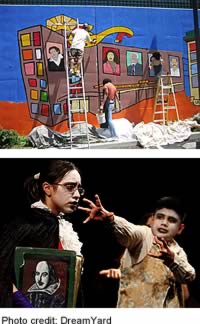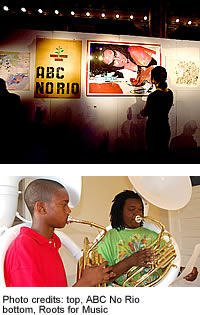
by Laura Cockman, 17, and Danielle Hensley, 13, Y-Press
In Des Moines, Iowa, music venues are not allowed to hold all-ages music events after 9 p.m. That has not sat well with under-21 activists who have been working with city officials in hopes of changing the code to make music venues more available to the city’s youth.
Click here to read these profiles:
All Ages Movement Project
Seattle, WA
DreamYard
Bronx, NY
Young people around America are following suit. In schools and local communities, they are fighting to keep arts programs available, something that is especially difficult in the midst of an economic recession.
“There’s the lack of resources because government funding for the arts, especially the education budgets, have been slashed, like one of the first things to go,” said Kevin Erickson, founder of the All-Ages Movement Project, an organization dedicated to helping and connecting young activists involved in the arts. Founded in Seattle in 2006 with support from the Tides Center, the network has more than 150 organizations in 37 states.
Rob Davidson and Jaclyn Shea of VH1’s Save the Music Foundation work firsthand with schools struggling to support arts programming. The New York-based foundation gives grants to public schools to supplement or initiate instrumental music programs, assisting nearly 1,700 elementary and middle schools since 1997.
“Arts are always on the chopping block,” said Shea, program manager.
Importance of the arts
Experts and kids agree — chopping out arts programming is shortsighted on many levels.
“There’s an overwhelming body of research and multiple studies that show that students who study music do better on standardized tests, do better in school. You know, their graduation rates are higher. They have a higher percentage of acceptances to college,” Shea said.
“It gets them to come to school,” added Davidson, program director for the foundation. “It makes school interesting, and it gives them another way in which to excel.”
Involvement in the arts also provides benefits far beyond the school day. Art—whether visual, musical or movement—is a means of expression, whether individual or cultural.
Jason Duchin, co-executive of DreamYard, a program founded in 1994 that focuses on bringing arts education to schools and communities in the Bronx, emphasizes art’s ability to foster creativity.
“One of the things that’s so important about arts education is it ignites a young person’s, or any person’s, ability to imagine, to dream, to envision what’s possible, not only in the world, but also for themselves,” he said.
Not only can participation in the arts help to foster individual growth, but teamwork in the form of bands or collaborative art projects can lead to community-building, Duchin said. He also pointed out that many of the same skills developed in artistic projects—creativity, flexibility, and goal-setting—are highly important skills in other career areas.
In fact, the arts industry itself is a burgeoning source of jobs, as nearly every company uses logos, commercials and catchy jingles.
“Right now when you look at the largest industries in America, the entertainment industry is one of the largest industries that we have, not only nationally but also internationally. And so it’s a huge economic engine, whether it be graphic design and working at a place like Google, or whether it means becoming an architect, etcetera,” said Duchin.
Worth fighting for
It is for all these reasons that youth are fighting to keep arts in their lives. According to Duchin, there are two situations in particular when youth will make a stand for arts programming: when they feel a program or venue is being unfairly taken away from them, or when they initiate a project themselves, raising money and negotiating red tape, if necessary, to accomplish something they believe in.
Examples of both kinds of activism abound. Young people have rallied behind favorite arts programs, usually threatened by school cutbacks but also lack of community funding.
Duchin described one such scenario. “In one of the schools that we work with in the Bronx, we run a poetry program. Because of the budget cuts, the principal was thinking about cutting the poetry program, and our young people barricaded the door and wouldn’t come out of the classroom until the principal assured them that they were going to have poetry in their school, which she did and so they came out of the classroom,” he said.
In addition, DreamYard incorporates youth at all decision-making levels, including naming a high school student to its board of directors. But young people also actively fight to keep access to the arts without the aid of high-powered organizations.
Erickson pointed to New York’s ABC No Rio as an example of youth fighting for an arts venue. In 1980, more than 30 artists occupied an abandoned building in the city’s East Village to exhibit works that commented on the city’s housing and land-use policies. Though police ended up shutting down the show, the city addressed the group’s concern for space and offered them a spot.
Young celebrities also have become advocates for arts education, with singer-rapper Sean Kingston appearing in a commercial supporting VH1’s Save the Music and http://www.dosomething.org/ partnership for music education.
In fact, scrolling through the youth-initiated projects on dosomething.org shows just how diverse these projects can be. For example, youth in the Extended Melody Project hold concerts to raise money for orphans and needy children; those involved in Roots for Music in New Orleans seek donations of musical instruments and materials for middle-schoolers in that city.
“In some communities, they’re using hip hop as a way to create dialogue around issues of violence in their community, or issues of police in their community, or even just as a vehicle to help give people the sense of strength and empowerment and self-determination to finish high school and to feel like they can transcend the material poverty that they’re in,” said Erickson.
Steps forward, back
New technology on cell phones and the Internet allow grassroots events and information to be spread more virally than ever before, even breaking down economic and social barriers.
“With some of the democratization technology, it’s easier to do,” Erickson explained. “The idea of a person without a lot of money being able to make like a video documentary about the issues that they’re facing in their community, or make a rap song about what’s going on in their neighborhood and share it with other people and other communities, ten years ago there were a lot more barriers that made that impossible.”
But more could be done. Erickson said the U.S. government has lagged behind other countries in supporting arts programs for youth.
“Government has this long history of supporting arts culture, but they also support things like museums, operas and ballets. Those institutions are totally important and worth supporting. They’re a vital part of the expressive life of the country,” he said. “At the same time, we need to realize that popular youth-driven kinds of art, like rock and punk and hip hop and all of the kinds of creative, experimental arts and music forms that are happening at grassroots levels in these populations of young people are equally worthy of government support.”




